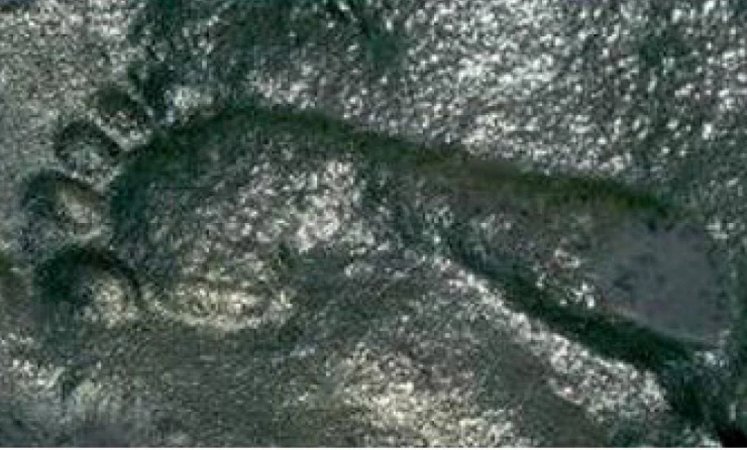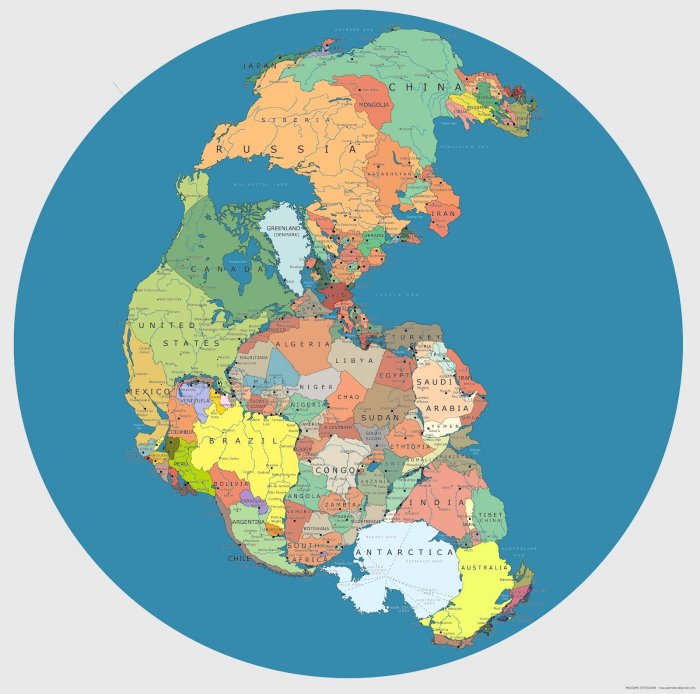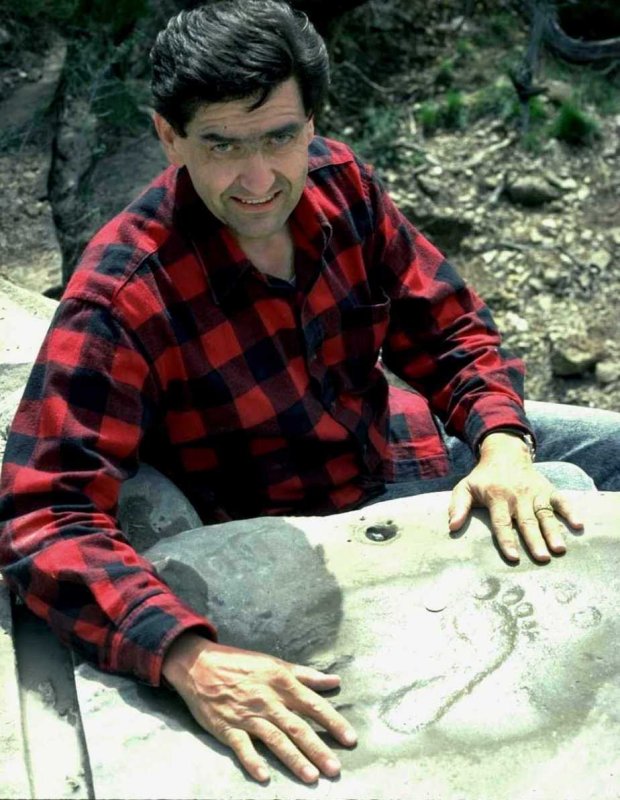Mystery Of The 290-Million-Year-Old Zapata Footprint In New Mexico
Jan Bartek - AncientPages.com - Fossilized footprints are often a subject of heated debates, especially if they are millions of years old and you cannot determine who made them.
In New Mexico, an extraordinary track is made in the mud. It's known as the Zapata footprint, and it is estimated "someone" made it about 290 million years ago.

The strange Zapata footprint is believed to be 290 million years old. Credit: Footprints in stone
Did human-like beings walk the Earth millions of years ago?
Is it a human footprint, or did a long-gone extinct animal make it? What did Earth look like 290 million years ago?
It was a time when the Earth's continents were fused in the supercontinent Pangea. Pangea broke into smaller continents in the Triassic period when dinosaurs first evolved. All plants and animals in those days would be unrecognizable to us.
The Zapata footprint was discovered many years ago by a hunter who informed his friend Don Shockey about the unusual find. Shockey, who knew about archaeology and anthropology, decided to investigate the footprint in the wilderness of New Mexico. He gathered a science team consisting of several experts. Two of the team's participants were Dr. Don Patton and Dr. Carl Baugh.

Stunning View Of What Supercontinent Pangea Looks Like Mapped With Modern Borders - Read More
Dr. Patton was an experienced geologist who had worked in several countries investigating fossils and participated in dinosaur excavations in Colorado, Texas, Wyoming, and Canada.
Dr. Baugh is the discoverer and excavation director of sixteen dinosaurs, including Acrocanthosaurus in Texas and Diplodocus in Colorado.
With such experienced science members, there should be an excellent chance to determine what kind of creature had left the footprint. The investigations should have been easy, but it wasn't due to several obstacles researchers encountered.
Soon after the science team obtained a mining permit to excavate in the area where the track was located, a local armed landowner threatened them for trespassing private land, claiming they were on this private land.

Examination of the Zapata fooprint. Credit: Footprints in stone
Shockey and his team showed the angry man their permission to excavate at the site and explained this was the BLM (Bureau of Land Management) property. Unfortunately, the landowner had a different opinion and told them to leave immediately. The team managed to take some photographs, but researchers were forced to interrupt the documentation, and they left the place in a hurry.
From an archaeological point of view, this was a tragedy because the hunter who had originally reported the discovery "had also reported that he had seen several other human footprints in the rock around the same area and showed Dr. Patton several photographs to validate his story." 1
According to Dr. Patton, the Zapata footprint is exceptionally shallow, making it very difficult to photograph.
So, who made the Zapata footprint? A majority will say humans did not exist millions of years ago. Could the Zapata footprint belong to a bipedal dinosaur? Maybe it can, but as we said at the beginning of this article, this happened during the age of Pangea, and scientists have concluded dinosaurs inhabited the world for some 160 million years. It means the Zapata footprint predates the dinosaurs.
Strange tracks in rocks have been found before, and they often pose a challenge to our historical timelines.
Some years ago, scientists discovered a set of controversial human-like footprints on Crete. These tracks are now putting the theory of human evolution to the test.
"The footprints are about 5.7 million years old from Trachilos in western Crete and have an unmistakably human-like form. It is especially true of the toes. The big toe is similar to our own in shape, size, and position. It is also associated with a distinct 'ball' on the sole, which is never present in apes." 2
Is it possible humans appeared much earlier than previously thought, or did unknown human-like beings leave behind footprints scientists cannot identify?
Written by Jan Bartek - AncientPages.com Staff Writer
Updated on April 4, 2023
Copyright © AncientPages.com All rights reserved. This material may not be published, broadcast, rewritten or redistributed in whole or part without the express written permission of AncientPages.com
Expand for referencesMore From Ancient Pages
-
 Venus Cloacina: Roman Goddess Of Sewers And Drains
Featured Stories | Dec 19, 2019
Venus Cloacina: Roman Goddess Of Sewers And Drains
Featured Stories | Dec 19, 2019 -
 Has Yorkshire’s Lost Underwater Town Ravenser Odd Finally Been Found?
News | Mar 26, 2022
Has Yorkshire’s Lost Underwater Town Ravenser Odd Finally Been Found?
News | Mar 26, 2022 -
 On This Day In History: Battle Of Langside Was Fought – On May 13, 1568
News | May 13, 2016
On This Day In History: Battle Of Langside Was Fought – On May 13, 1568
News | May 13, 2016 -
 On This Day In History: Ferdinand Magellan Discovers Guam – On Mar 6, 1521
News | Mar 6, 2017
On This Day In History: Ferdinand Magellan Discovers Guam – On Mar 6, 1521
News | Mar 6, 2017 -
 Vercingetorix – Visionary Nobleman And Mighty Warrior Who Led Army Of Gallic People Against The Roman Empire
Featured Stories | Feb 10, 2018
Vercingetorix – Visionary Nobleman And Mighty Warrior Who Led Army Of Gallic People Against The Roman Empire
Featured Stories | Feb 10, 2018 -
 Unexplained Historical Mass Disappearances – Lost Without Trace – Part 1
Featured Stories | May 31, 2019
Unexplained Historical Mass Disappearances – Lost Without Trace – Part 1
Featured Stories | May 31, 2019 -
 Atlit Yam – Fate Of The 9,000-Year-Old Underwater Megalithic Site With A Huge Stone Circle
Featured Stories | Jun 14, 2021
Atlit Yam – Fate Of The 9,000-Year-Old Underwater Megalithic Site With A Huge Stone Circle
Featured Stories | Jun 14, 2021 -
 Incredibly Well-Preserved Viking Age Ski Discovered Under Melting Ice
Archaeology | Nov 8, 2022
Incredibly Well-Preserved Viking Age Ski Discovered Under Melting Ice
Archaeology | Nov 8, 2022 -
 Intact 2,600-Year-Old Etruscan Tomb Opened In Vulci- Exceptionally Rare Artifacts Found Inside
Archaeology | Oct 31, 2023
Intact 2,600-Year-Old Etruscan Tomb Opened In Vulci- Exceptionally Rare Artifacts Found Inside
Archaeology | Oct 31, 2023 -
 Statuettes Of Gods And Goddesses Unearthed At Ancient Site Of Kültepe
Archaeology | Sep 16, 2020
Statuettes Of Gods And Goddesses Unearthed At Ancient Site Of Kültepe
Archaeology | Sep 16, 2020 -
 Forbidden Knowledge: Secret Ancient Gates Of The Shining Ones – The Beginning – Part 1
Featured Stories | Jul 12, 2019
Forbidden Knowledge: Secret Ancient Gates Of The Shining Ones – The Beginning – Part 1
Featured Stories | Jul 12, 2019 -
 John Hawkwood ‘John Sharp’: Feared, English Mercenary And His White Company In 14th Century Italy
Featured Stories | Jun 20, 2020
John Hawkwood ‘John Sharp’: Feared, English Mercenary And His White Company In 14th Century Italy
Featured Stories | Jun 20, 2020 -
 Did The Dogon Tribe Have Knowledge Of Theoretical Physics 5,000 Years Ago?
Civilizations | Aug 2, 2017
Did The Dogon Tribe Have Knowledge Of Theoretical Physics 5,000 Years Ago?
Civilizations | Aug 2, 2017 -
 What Can The Fate Of Ancient Cities Teach Us About Surviving Climate Change
Archaeology | Oct 1, 2021
What Can The Fate Of Ancient Cities Teach Us About Surviving Climate Change
Archaeology | Oct 1, 2021 -
 26,000-Year-Old Footprints In Chauvet Cave: Oldest Evidence Of Human-Canine Relationship
Featured Stories | Dec 29, 2016
26,000-Year-Old Footprints In Chauvet Cave: Oldest Evidence Of Human-Canine Relationship
Featured Stories | Dec 29, 2016 -
 World’s Oldest Hand And Footprints Discovered On The Tibetan Plateau Are 226,000-Year-Old!
Archaeology | Sep 15, 2021
World’s Oldest Hand And Footprints Discovered On The Tibetan Plateau Are 226,000-Year-Old!
Archaeology | Sep 15, 2021 -
 Evidence Europeans Started Using Milk 7,400 Years Ago – New Study
Archaeology | Oct 18, 2022
Evidence Europeans Started Using Milk 7,400 Years Ago – New Study
Archaeology | Oct 18, 2022 -
 Ancient History Of Dentistry
Featured Stories | Jun 22, 2018
Ancient History Of Dentistry
Featured Stories | Jun 22, 2018 -
 On This Day In History: George Plantagenet Privately Executed At The Tower Of London – On Feb 18, 1478
News | Feb 18, 2017
On This Day In History: George Plantagenet Privately Executed At The Tower Of London – On Feb 18, 1478
News | Feb 18, 2017 -
 On This Day In History: First Battle Of Gaza Was Fought – On March 26, 1917
News | Mar 26, 2017
On This Day In History: First Battle Of Gaza Was Fought – On March 26, 1917
News | Mar 26, 2017
